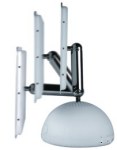|

Inside
the magazine
Self-help message board
Article reprints
How to contact us
Web links directory
Software downloads
Tips and advice
Fire-wire campaign
Subscribe today
Help Me, I'm new!
Fair pricing petition
Home

In
Software Downloads:
Adobe
Premiere 6 (trial)
Paint Shop Pro 7 (trial)
Tips
and Advice:
How to get started with
computer video editing
Fire-wire
Campaign:
Join our ongoing campaign
|
Apple iMac with
SuperDrive
 Apple
went far out on a limb in 1998 by launching an all-in-one, semi-transparent
desktop computer that dispensed with much old technology - floppy disk
drives, SCSI and adb serial ports - and connected to peripherals by
USB. Around six million iMacs later - and the argument won - Apple has
introduced a successor which, at first sight, looks even more radical Apple
went far out on a limb in 1998 by launching an all-in-one, semi-transparent
desktop computer that dispensed with much old technology - floppy disk
drives, SCSI and adb serial ports - and connected to peripherals by
USB. Around six million iMacs later - and the argument won - Apple has
introduced a successor which, at first sight, looks even more radical
The latest-generation
iMac has broken a number of barriers in computer design. For a kick
off, the system box is the shape of half a football, incorporating all
the drives, motherboard and power supply. It has an ice-white finish,
and a chrome-plated arm sprouts from the top. From the arm is suspended
a 15in LCD monitor that glides without effort to precisely where the
user moves it.
The monitor is a gem - even though it lacks resolutions higher than
1024 x 768. But the arm from which it's suspended is really the jewel
in the crown. It allows the monitor to be rotated left/right through
80 degrees, moved up and down through 90 degrees, and tilted at the
neck through about 40 degrees. This is the first display of its kind
we've seen - we think it's the first of its kind there's ever been -
and it offers a level of versatility we imagine will quickly become
indispensable.
The ability to easily put the monitor in the right position for a job
means the computer works around the user, rather than the user, and
often the furniture and lighting in a room, around it. Using the iMac
made us realise how quickly it becomes natural to put the monitor where
it's best suited. When typing documents, for instance, we found it best
to have the monitor up near eye level, but when browsing the web we
preferred it low down, almost like reading a book.
The two other main elements of the interface aren't anything like so
impressive. The keyboard is certainly useable, but the white finish
will soon get grubby, and its (fixed) USB cable is a little too short.
The optical mouse is good, and connects to the keyboard via USB but,
unfortunately, Apple persists in using the single button design. This
is despite the fact that Apple's operating systems have long supported
a second mouse button - a feature that makes life a lot easier, as so
many context-sensitive options are just a right-click away. Some Mac
veterans will be used to accessing these menus a different way, by Ctrl-clicking,
but we'd advise everyone else to switch to a two-button mouse at the
earliest opportunity.
Ports and the power button are around the back of the system box. This
keeps the lines smooth but can be a bit irritating if they're being
accessed regularly. However, in all the time we've been using the iMac
with OS X, we've not turned it off at all - the machine puts itself
to sleep after a set period of time - we only had to turn it on when
we first took it out of the box.
SuperDrive
A Pioneer DVD-R/DVD-RW burner - Apple calls it a SuperDrive - has been
available with two-piece G4 PowerMacs for some time, but this is the
first iMac to offer DVD burning and, of course, the first to come with
Apple's iDVD authoring software. The iMac's SuperDrive drive is the
new Pioneer DVR-104 (the retail version is the A04). This is a revision
of the DVR-103 used in PowerMacs and on a number of Windows PCs, and
also sold separately as the DVR-A03.
There is little difference between old and new. DVD read speed has been
increased from 4x to 6x, and the drive is compatible with high-speed
CD-RW discs (those able to be written to at up to 10x) but burning to
DVD is the same 4x rate as the 103. Pioneer says the 104 is 1cm shorter
than the 103 and has a quieter cooling fan. Though not relevant to Apple's
implementation, it can be used mounted on its side, not just laying
flat. The full range of speeds is DVD-R 2x, DVD-ROM 6x, CD-R 8x, CD-RW
8x, CD-ROM 24x. As with Pioneer burners fitted to earlier Macs, Apple
has not implemented rewritable DVD-RW - so video editors won't be able
to proof their DVDs before burning them to write-once DVD-Rs.
The range-leading model we tested - the only one with a built-in DVD
burner - has an 800MHz processor and comes with 256MByte RAM and a 60GByte/5,400rpm
hard disk. The other two models each run at 700MHz. One, costing £1,400,
has 256MByte RAM, a combi DVD player/CD-RW burner and a 40GByte HDD.
The other, at £1,250, has the same hard disk capacity but only
128MByte RAM and just a CD-RW burner. All have 256KByte of level two
cache running at clock speed. But there's no L3 cache and the system
bus only runs at 100MHz - factors which put the iMac at a disadvantage
compared to its big brother, the PowerMac, which is now more than ever
being targeted at pro users.
An nVidia GeForce2 MX graphics processor is integrated into each model
and, though not ground breaking, is powerful enough for most users.
Apple supplies external speakers only with the top two models - a pair
of Apple Pro speakers. These are grapefruit-sized, see-through plastic
models that look a lot better than they sound, and are far inferior
to the sort of speakers you'd expect to get with Windows PCs costing
considerably less. Each iMac has a headphone port around the back -
which can instead be used to connect a decent set of powered speakers.
The iMac also supports external USB audio devices, and carries a concealed
microphone on its LCD monitor. The full socket line-up takes in three
USB ports and two FireWire, plus connectors for the built-in 56K modem
and 10/100 Ethernet networking.
Conclusion
With its swivelling LCD monitor, the latest iMac is an amazing design
that's been superbly implemented. More than that - and especially since
it has a fast processor and a built in DVD burner - it's a very capable
package, though a lot of credit must go to the operating systems and
rich software bundle that are included. Most users will hit the ground
running and soon be producing first-class results.
While internal upgrade options are limited, lots of features are built
in, such as networking and a modem, so the need for expansion is reduced.
But, having FireWire and USB ports means that external hardware - including
hard disks and USB video capture devices - can be easily connected.
Prices were increased by about £75 soon after the launch, but
this was said to be due to unavoidable increases in RAM and LCDs. Cynics,
though, reckon that Apple is simply exploiting a situation where demand
for iMacs has exceeded supply. Whatever the case, the top-end iMac we
reviewed is still excellent value as a one-stop solution for video editing
and DVD-creation. It performs well, it's very easy to use and it sets
a standard that competitors should strive to equal and will find hard
to beat.
Tim Callaghan
For more
details, see the June issue of Computer Video magazine.
|
Recent features...
View
The Archive
Reviewed in June's issue:
NAB 2002
Apple Final Cut Pro 3
Apple iMac with SuperDrive
Pioneer DVR-7000
In June's news:
Photoshop supports OS X
The end for tape?
DVD burning for Vaios
Iomega external HDDs
ADS 2.5in FireWire drive bay
Pinnacle DV500
Roxio WinOnCD
CD Creator DVD support
|





 Apple
went far out on a limb in 1998 by launching an all-in-one, semi-transparent
desktop computer that dispensed with much old technology - floppy disk
drives, SCSI and adb serial ports - and connected to peripherals by
USB. Around six million iMacs later - and the argument won - Apple has
introduced a successor which, at first sight, looks even more radical
Apple
went far out on a limb in 1998 by launching an all-in-one, semi-transparent
desktop computer that dispensed with much old technology - floppy disk
drives, SCSI and adb serial ports - and connected to peripherals by
USB. Around six million iMacs later - and the argument won - Apple has
introduced a successor which, at first sight, looks even more radical